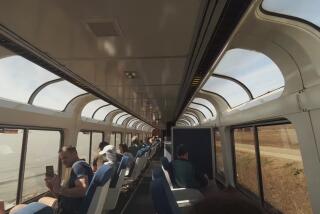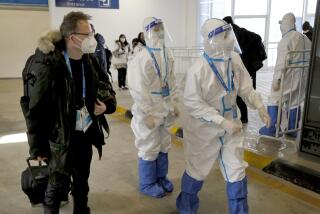Classic China, framed by a windowpane
The night before I was to leave for Tibet on the new Beijing-Lhasa Express, my travel agent called to say he couldn’t get me a seat. The highest railway in the world, inaugurated last July, is a hot ticket. So, I flew from Beijing to Lhasa, where my guide greeted me with a white silk scarf, or khatag, and something even better: a return train ticket.
Most tourists take the express in the opposite direction. But no matter which way you go, the railway is the ride of a lifetime.
It arcs for 2,525 miles across the heartland of the Middle Kingdom and the Tibetan Plateau. It has 675 tunnels and bridges. Eighty percent of the last segment completed in 2006 between Lhasa and Golmud in Qinghai province is at more than 13,000 feet, and the top of the route is at 16,640-foot Tanggula Pass.
The $4.2-billion Beijing-Lhasa Express is the flashiest recent addition to China’s rapidly expanding railway network, which will get about 62,000 miles of new track in the next three years. It is also the most controversial, seen by critics as a means for China to despoil Tibet’s cultural and mineral riches, although few would debate that tourist development has had a positive effect on the economy.
A new station at the Tibetan end of the line also serves the more southerly Sichuan-Tibet Railway. I waited there for the Beijing-bound train, which leaves Lhasa at 8 a.m. daily, standing among Chinese tour groups, Tibetan businessmen, European backpackers and American students, all with overstuffed bags and high expectations.
I took seat No. 31 in Car 6 with just a fold-out map of China to keep me oriented. Each car had an electronic sign showing the speed, altitude and next stop. Apart from the frequently repeated “You are welcome to take this train,” announcements on board were chiefly in Chinese.
I had booked one of the four-berth soft-sleeper compartments that foreigners seem to prefer. They’re in front of the six-berth sleepers the Chinese favor and the hard-seat cars holding mostly Tibetans.
In my compartment, the beds were stacked up like facing bunk beds across a table, with pressed cotton sheets, pillows and comforters. Each berth was equipped with a TV monitor and headset as well as oxygen canisters for those with altitude sickness. The curtained window at my elbow was spotlessly clean and slightly tinted. It was as shipshape as a long-distance train compartment could be, at least at the beginning.
My travel companions were two young German backpackers and a Chinese policeman from Harbin. He spent much of the trip with friends in the hard seats while the backpackers drank beer in the dining car.
I liked hanging around in a pull-down seat in the corridor, where I watched the scenery. It was terrific, especially the first day on the wide, treeless Tibetan Plateau, where villagers gazed at the passing train and yaks bolted off the tracks. Up here, the curvature of the Earth seemed almost apparent to the naked eye, and every few minutes another nameless range of snow-capped peaks with glaciers streaming down their sides appeared on the horizon.
Closer to the tracks, snowmelt collected in puddle-like lakes, and rivers with ice-crusted banks made lazy S-curves across the nubby brown tundra.
Hundreds of miles of the railway cross fragile permafrost and the range of the endangered Tibetan antelope. Myriad high-tech engineering solutions were required, such as building subterranean game passageways and piping liquid nitrogen through the tracks to keep them from buckling during a thaw.
Tanggula Pass came and went, almost indistinguishable from the rest of the high country. Most of the way, we followed the Qinghai-Tibet Highway, completed 53 years ago. We stopped rarely and only briefly.
When it was time to eat, we filed into the dining car for an unappetizing meal served on tin plates: potatoes, cabbage, greens, a slice of Spam, half a hard-boiled egg and rice. The fare improved as the journey continued and the staff took on produce in big cities. But by then, most people were subsisting on snacks, instant noodles or beer.
The last thing I remember on the first night was a 30-minute stop in the lonesome city of Golmud, devoted to mining and chemical manufacture. Smokers piled out of the train, and a group of drunk NYU students played soccer on the platform
When I awoke the next morning, we were nearing Xining, capital of Qinghai province. By then, the toilets at the rear of the car were in terrible condition. Lacking shower facilities, I did my ablutions at a bank of sinks beside two expectorating men.
All that day, China passed by my window, decorated in sunshine and cherry blossoms. I closed my eyes for big, ugly, polluted cities like Lanzhou in Gansu province and opened them for the idyllic countryside. The second night, I went to sleep around Xian, home of the terra-cotta warriors, and awoke just in time for our 8 a.m. arrival at Beijing’s West Station, reflecting that in two days I’d seen more of the country than many Chinese see in their lifetimes.
More to Read
Sign up for The Wild
We’ll help you find the best places to hike, bike and run, as well as the perfect silent spots for meditation and yoga.
You may occasionally receive promotional content from the Los Angeles Times.






